15 Minutes on the Erie Canal
Doug shared some history of the Erie Canal. Begun in 1817 and completed in 1825, the 360 mile-long canal was 40 feet wide and 4 feet deep. This marvel of engineering connected the Great Lakes to the Atlantic Ocean and helped spur the growth of the United States. In 1820, the population of Palmyra was 3,124; that of Rochester was about 1,500. Our local area was literally the western edge of civilization. The canal changed that.
Dick Kirchhoff (r) introduced today's guest, Doug Wilson.
In 1834 work began on improvements to the canal, which had long since exceeded its expected usage. The canal was widened to 70 feet and deepened to 7 feet. Some locks were widened; others rebuilt in new locations, and many new aqueducts were constructed. Finished in 1862, this enlargement resulted in what we call the Old Erie Canal or the Enlarged Erie Canal.
The canal dramatically lowered the cost of shipping between the Mid-west and the Northeast. Manufactured goods from the East were shipped out West, and food costs for the Eastern cities were much lower. In addition to goods, the canal helped expand the flow of people and ideas in the 19th century. Many immigrants arrived in New York City and eventually spread across New York and to the West. With them, they brought their different perspectives and cultural ideals.
In 1918 the Canal was replaced by the larger NY State Barge Canal. New technologies allowed the canal system to utilize existing rivers. Where that wasn’t possible, such as our area, the canal was enlarged to 120 feet wide and 12 feet deep. That project ultimately did not prevent the canal’s becoming obsolete for commercial shipping. Since the 1990s, the Canal has been primarily used by recreational traffic. You can still travel by boat from Albany to Buffalo.
The Erie Canalway National Heritage Corridor was established by Congress in 2000. It includes the Erie, Cayuga-Seneca, Oswego, and Champlain Canals. It encompasses more than 4800 square miles in 23 counties. Land within the ECNHC is not owned or managed by the federal government. Instead, a conglomeration of people, businesses, historical and environmental organizations work together, along with towns, cities, counties, and the State in order to protect and preserve the corridor. For more information about the Erie Canalway National Heritage Corridor, please visit their website: www.eriecanalway.org
Download the website sponsorship guide


